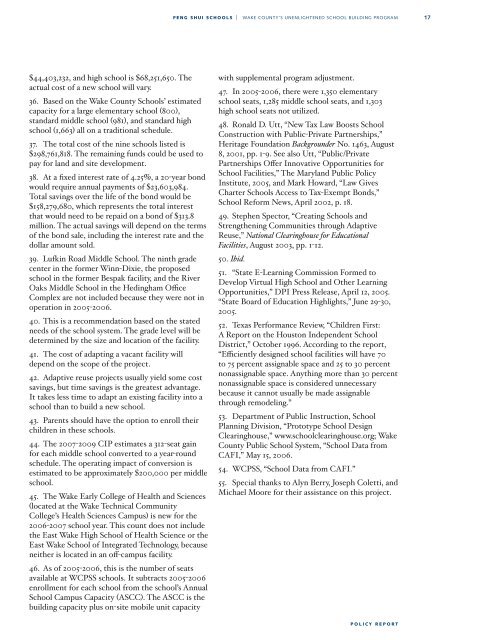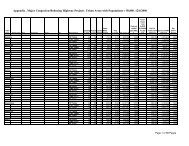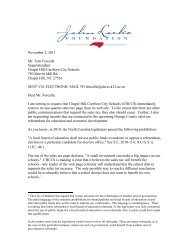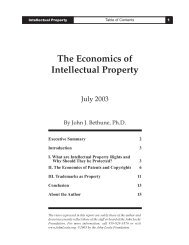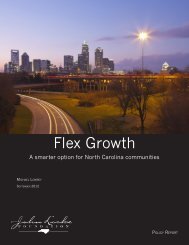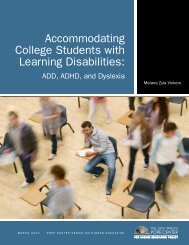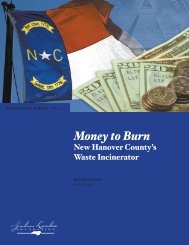Feng Shui Schools - John Locke Foundation
Feng Shui Schools - John Locke Foundation
Feng Shui Schools - John Locke Foundation
Create successful ePaper yourself
Turn your PDF publications into a flip-book with our unique Google optimized e-Paper software.
f e n g s h u i s c h o o l s |<br />
wake County’s unenlightened school building program<br />
17<br />
$44,403,232, and high school is $68,251,650. The<br />
actual cost of a new school will vary.<br />
36. Based on the Wake County <strong>Schools</strong>’ estimated<br />
capacity for a large elementary school (800),<br />
standard middle school (981), and standard high<br />
school (1,663) all on a traditional schedule.<br />
37. The total cost of the nine schools listed is<br />
$298,761,818. The remaining funds could be used to<br />
pay for land and site development.<br />
38. At a fixed interest rate of 4.25%, a 20-year bond<br />
would require annual payments of $23,603,984.<br />
Total savings over the life of the bond would be<br />
$158,279,680, which represents the total interest<br />
that would need to be repaid on a bond of $313.8<br />
million. The actual savings will depend on the terms<br />
of the bond sale, including the interest rate and the<br />
dollar amount sold.<br />
39. Lufkin Road Middle School. The ninth grade<br />
center in the former Winn-Dixie, the proposed<br />
school in the former Bespak facility, and the River<br />
Oaks Middle School in the Hedingham Office<br />
Complex are not included because they were not in<br />
operation in 2005-2006.<br />
40. This is a recommendation based on the stated<br />
needs of the school system. The grade level will be<br />
determined by the size and location of the facility.<br />
41. The cost of adapting a vacant facility will<br />
depend on the scope of the project.<br />
42. Adaptive reuse projects usually yield some cost<br />
savings, but time savings is the greatest advantage.<br />
It takes less time to adapt an existing facility into a<br />
school than to build a new school.<br />
43. Parents should have the option to enroll their<br />
children in these schools.<br />
44. The 2007-2009 CIP estimates a 312-seat gain<br />
for each middle school converted to a year-round<br />
schedule. The operating impact of conversion is<br />
estimated to be approximately $200,000 per middle<br />
school.<br />
45. The Wake Early College of Health and Sciences<br />
(located at the Wake Technical Community<br />
College’s Health Sciences Campus) is new for the<br />
2006-2007 school year. This count does not include<br />
the East Wake High School of Health Science or the<br />
East Wake School of Integrated Technology, because<br />
neither is located in an off-campus facility.<br />
46. As of 2005-2006, this is the number of seats<br />
available at WCPSS schools. It subtracts 2005-2006<br />
enrollment for each school from the school’s Annual<br />
School Campus Capacity (ASCC). The ASCC is the<br />
building capacity plus on-site mobile unit capacity<br />
with supplemental program adjustment.<br />
47. In 2005-2006, there were 1,350 elementary<br />
school seats, 1,285 middle school seats, and 1,303<br />
high school seats not utilized.<br />
48. Ronald D. Utt, “New Tax Law Boosts School<br />
Construction with Public-Private Partnerships,”<br />
Heritage <strong>Foundation</strong> Backgrounder No. 1463, August<br />
8, 2001, pp. 1-9. See also Utt, “Public/Private<br />
Partnerships Offer Innovative Opportunities for<br />
School Facilities,” The Maryland Public Policy<br />
Institute, 2005, and Mark Howard, “Law Gives<br />
Charter <strong>Schools</strong> Access to Tax-Exempt Bonds,”<br />
School Reform News, April 2002, p. 18.<br />
49. Stephen Spector, “Creating <strong>Schools</strong> and<br />
Strengthening Communities through Adaptive<br />
Reuse,” National Clearinghouse for Educational<br />
Facilities, August 2003, pp. 1-12.<br />
50. Ibid.<br />
51. “State E-Learning Commission Formed to<br />
Develop Virtual High School and Other Learning<br />
Opportunities,” DPI Press Release, April 12, 2005.<br />
“State Board of Education Highlights,” June 29-30,<br />
2005.<br />
52. Texas Performance Review, “Children First:<br />
A Report on the Houston Independent School<br />
District,” October 1996. According to the report,<br />
“Efficiently designed school facilities will have 70<br />
to 75 percent assignable space and 25 to 30 percent<br />
nonassignable space. Anything more than 30 percent<br />
nonassignable space is considered unnecessary<br />
because it cannot usually be made assignable<br />
through remodeling.”<br />
53. Department of Public Instruction, School<br />
Planning Division, “Prototype School Design<br />
Clearinghouse,” www.schoolclearinghouse.org; Wake<br />
County Public School System, “School Data from<br />
CAFI,” May 15, 2006.<br />
54. WCPSS, “School Data from CAFI.”<br />
55. Special thanks to Alyn Berry, Joseph Coletti, and<br />
Michael Moore for their assistance on this project.<br />
p o l i c y r e p o r t


